By Frederic Laloux and originally published here at thejourney.reinventingorganizations.com
Frederic Laloux looks at Strategic Planning in a Teal World
Today we often plan much more that we need to. From that it’s not far to the typical misunderstanding: planning is bad!
It’s not. There are simply two pitfalls to avoid: planning too much and believing our plans.
6 mins 11 secs
Comment guidelines (for original site of publication)
My hope is for the comments below the video to surface our collective wisdom on the topic. This could enrich the videos tremendously.
Have you experienced something similar in your own journey? What did you do about it? If you have something meaty to share, please add[on the original publication webpage] a link to an article, a video … Feel free to agree or disagree with what I say, but always: please keep it on topic, relevant, practical. And of course, let’s keep things respectful and kind. Please don’t comment if what you say is off-topic or wouldn’t benefit viewers of this page.
Be sure to listen to the very end of each video, and sense whether you feel called to contribute to Frederic’s work via his gift economy offerings like these.
Republished with permission.
Featured Image added by Enlivening Edge Magazine.





Thank you for the insights.
I believe there are two different types of plans that have different approaches and requirements.
1. on the one hand there is the plan, which gives time specifications, when something should happen in time.
2. then there is the plan, which describes only the where and how – e.g. the architect’s plan, how a house should look like.
3. plans that describe the sequence or dependencies, what should happen after that.
4. plans that represent mixed forms, e.g. financial plans. Here we have taken in a lot of money at a certain point in time, which can then be spent elsewhere. Here the expenditure depends on the planned income.
I think we agree that plans that I mentioned in 2. should be implemented exactly as planned, if possible. Otherwise, there may be static problems, or the house can not be entered because the door was forgotten. Here we are in the complicated habitat in the Cynefin framework according to Dave Snowden.
For plans in the first category, if it regulates when people should do something, the plan will usually be wrong by the time the ink dries. Since humans and dependencies in the world all play in the complex habitat. Thus, these are best met with emergent pratices.
Plans which only describe dependencies are again to be classified in the complex habitat and can be worked off accordingly one after the other.
The mixed forms of plans which describe on the one hand dependencies, on the other hand a temporal planning are already complex by itself. For an enterprise, however, in certain respects indispensable, since without these plans larger investments cannot be begun, and/or liquidity difficulties cannot be met in time.
For this reason, the rolling forecast method is suitable for this type of plan. According to this method, financial plans are not fixed for months or years, but are adjusted again and again at short notice according to the latest developments.